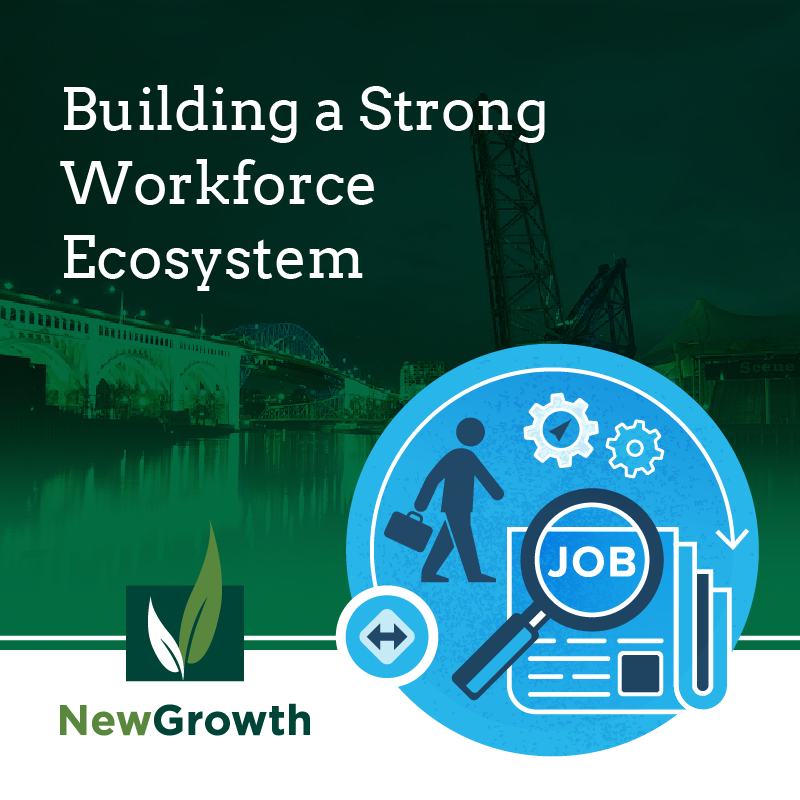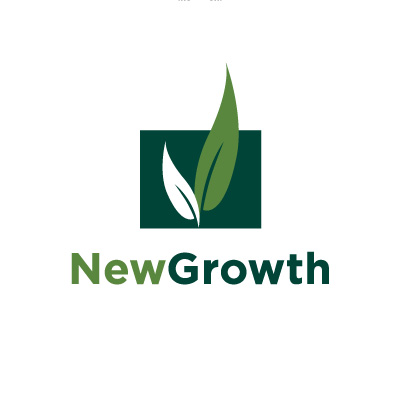A strong workforce ecosystem is an essential component for thriving communities. Drawing from our years of conducting research and evaluating workforce development projects, New Growth has noted three functions which are needed to support a strong workforce ecosystem: organizing the supply side, organizing the demand-side, and organizing systems change agendas. When combined, these functions help to reduce labor market inefficiencies through ensuring the community is aligned around a shared goal, aligning training, and effectively connecting job seekers to employers.
Organizing the Supply Side- This function focuses on strategies to support organizations who prepare, place, educate or train job seekers. Examples of this function include:
- Collective impact models and partnerships which plan and develop common strategies. While partnership structure is defined to meet the needs of their community, formal collective impact models on the whole have more capacity to convene community stakeholders and the authority needed to bring more reticent parties to the table.
- Guided pathways help students gain stackable credentials and credits along their education and training journey, in the same or related field. When implemented well, organizations which offer guided pathways place job seekers or students into high demand/living wage jobs, or place them on an accelerated path to gain the experience and skill-attainment needed to secure this type of employment.
- Supportive programs that meet people where they are and place them into immediate employment, but acknowledge that education and training is the route to wage advancement. Many of these programs offer a stipend for students working their way through the program or compel their employer-partners to pay a wage while the student is going through training. This helps students stay focused on their education and training, improving retention and completion of the programs.
- Comprehensive support services, especially legal, transportation, and childcare which help participants/students complete their training program. Many initiatives use case managers and supportive staff to help provide or connect participants with resources in the community and provide funding to provide supportive services such as transportation and child care.
Organizing the Demand Side- This function focuses on strategies which interface directly with employers and support initiatives which help employers change practices. Examples of this function include:
- Business-led collaborative models and partnerships that work to convene partners and/or lead collaboratives. These partnerships and collaboratives are often financed by employers. These partnerships identify common hiring challenges and engage with training providers, funders, and community based organizations to help build strategies to address their needs.
- Capacity to overcome business reticence including organizations that have extensive sales, outreach, and adaptive consulting capacity to engage businesses. To accomplish this and build a pool of employer partners, having a dedicated outreach staff helps the organization maintain and follow up with employers.
- Learn and earn is a method used by many of the training initiatives, both school-based and independent. This method not only supports the student as they are moving through the program, improving retention and completion, it also proves the value of investing in training and development of employees to businesses, which helps with deeper engagement and helps attract more employers.
- Support “the middle”, which is the year or two that it takes to prove an ROI of a new hiring and advancement strategy to businesses. This support helps employers adopt and implement new strategies with lower risk, which builds trust and creates deeper partnerships.
Organizing Systems Change Agendas- This function focuses on building the connective tissue between service organizations, education and training providers, and employers to find common ground and a shared plan of action to drive change. Examples of this function include:
- Learning communities that help service providers and business become informed and trained on new models. These learning communities are often delivered in partnership with community or government leaders and offer professional development, networking, and a space information sharing. Sometimes these learning communities meet with policymakers to recommend new policies and practices for potential adoption.
- Research and evaluation to prove that models work. Third party evaluations help make the case for the concepts effectiveness and can help funders make informed investment decisions.
- Leadership around the development of policy agendas at local and state levels, including convening, reports, and communications. Many collective impact partnerships or community collaboratives have a dedicated advocacy strategy which seeks to promote community-based strategies and identify and raise awareness of challenges facing people and businesses in their geographic footprint.
- Leadership within the philanthropic and funder community . Philanthropic collaborative help to strategy for industry and training partnerships and can align and leverage over $25,000,000 funding for prioritized initiatives.
- Community support of thought leaders. All of these approaches require collaborative leadership and local expertise to contextualize and implement. Continuing to convene and support other thought leaders builds the will and momentum needed to implement innovative strategies.
Working to build these three functions in a community can help to ensure that businesses have a strong workforce and people have opportunities to advance in careers. Do you have a program that aligns to one or more of these functions which needs resource or research support? Contact our Project Manager, Kaci Roach. She can help connect you with the expertise you need to support the development and growth of your program.

